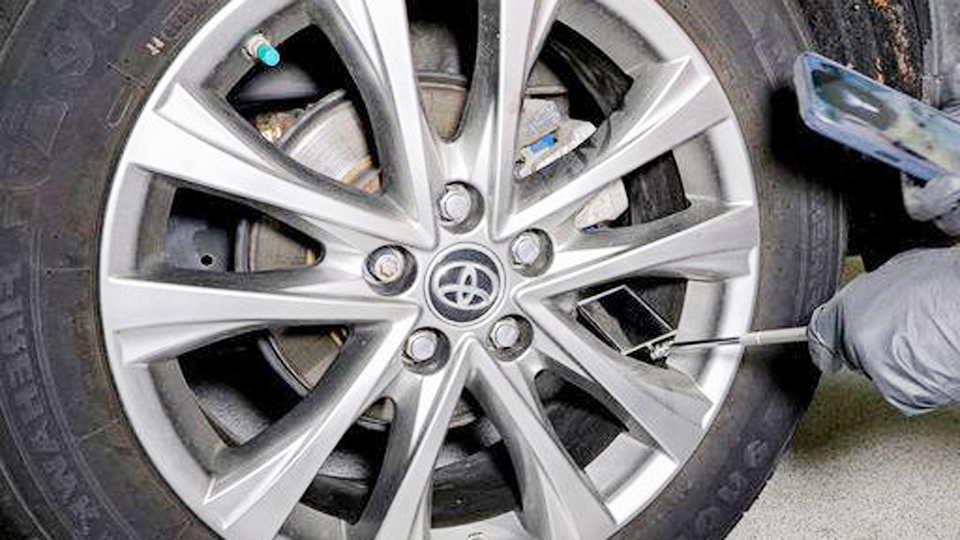How to Inspect Brake Pads Without Removing the Wheel?
You’re about to head out on a road trip, but you hear a faint squeal when you hit the brakes. You wonder if your brake pads are worn, but you don’t want to spend an hour pulling off the wheels to check. That’s exactly where I was a few years ago with my 2005 Chevy Silverado. I wanted a quick way to inspect my brake pads without the hassle of removing the tires. After some trial and error, plus tips from mechanics and my own repairs,

Photo by msn
I learned how to check brake pads without taking the wheel off. It’s a simple trick that saves time and keeps your car safe. I’ve done this on my truck, my wife’s Honda CR-V, and a buddy’s Ford Focus, and I’m here to share the steps, tools, and tips to help you do it too. Whether you’re a first-time DIYer or a seasoned car enthusiast, this guide will show you how to inspect your brake pads like a pro.
Why Inspect Brake Pads Regularly?
Brake pads are the heart of your car’s braking system. They press against the rotors to slow or stop your wheels, taking a beating every time you hit the pedal. I learned this the hard way when I ignored a squealing noise on my Chevy and ended up with worn-out pads that damaged a rotor. Checking your brake pads regularly keeps you safe and saves money. Here’s why it matters, based on my experience:
- Safety First: Worn brake pads reduce stopping power, making accidents more likely. I felt this when my truck took longer to stop at a light.
- Prevent Damage: Thin pads can wear down rotors, costing $200–$500 to replace. I paid $300 for a new rotor after neglecting my pads.
- Save Money: Catching worn pads early means replacing them for $20–$50, not hundreds for bigger repairs.
- Better Performance: Fresh pads make braking smooth and quiet. My Chevy felt like new after a pad swap.
- Peace of Mind: Knowing your brakes are good lets you drive worry-free. I check mine before every long trip.
Inspecting pads every 6 months or 5,000 miles keeps you ahead of problems. I mark my calendar to stay on top of it.
Can You Really Inspect Brake Pads Without Removing the Wheel?
Yes, you can! I was skeptical at first, thinking I’d need to pull the wheel to see anything. But on most cars with disc brakes, you can peek at the brake pads through the caliper or wheel spokes without taking the tire off. It’s not as detailed as a full inspection, but it’s enough to spot worn pads or obvious issues.
I’ve done this on my Chevy’s front brakes, which have open alloy wheels, and it took just 5 minutes per side. For cars with tight wheel designs or drum brakes, it’s trickier, but I’ll share workarounds to make it work.
This method is great for quick checks, like before a trip or when you hear a noise. If you spot a problem, you can decide whether to remove the wheel for a closer look. I’ve saved hours using this trick, and it’s become my go-to for routine brake checks.
Tools and Materials You’ll Need
You don’t need a full toolbox to inspect brake pads without removing the wheel. I keep it simple, using just a few items I already have in my garage. Here’s what I grab:
- Flashlight: To see into dark spots around the caliper. I use a small LED flashlight for bright light.
- Ruler or Brake Pad Gauge: To measure pad thickness (optional). I got a $5 gauge online.
- Clean Rag: To wipe dirt off the caliper or wheel. I keep old towels handy.
- Gloves: To protect your hands from grime. I wear cheap nitrile gloves.
- Jack and Jack Stands (Optional): For better access if the wheel is tight. I use a $50 floor jack.
- Tire Iron (Optional): To loosen lug nuts if you need to adjust the wheel. My Chevy’s iron works fine.
These tools make the job quick and easy. I store them in a small bag so I’m ready to check brakes anytime.
Step-by-Step Guide to Inspecting Brake Pads Without Removing the Wheel
Inspecting brake pads without removing the wheel is straightforward once you know where to look. I’ve done this dozens of times, and here’s the process I follow, based on my Chevy’s front disc brakes:
Step 1: Park and Prepare the Car
Park on a flat surface and engage the parking brake. Turn on your hazard lights if you’re on the roadside. I always check my Chevy in the driveway for safety. Let the brakes cool if you’ve been driving—hot brakes can burn you. I wait 30 minutes after a drive to start.
Step 2: Locate the Brake Caliper
The brake caliper is the metal piece that houses the pads and presses them against the rotor. It’s behind the wheel, usually visible through the spokes. I kneel by my Chevy’s front wheel and look for a shiny metal part with bolts. If your wheel has tight spokes, turn the steering wheel left or right to get a better view. I turned my truck’s wheel fully left to see the driver-side caliper clearly.
Step 3: Look at the Brake Pads
Peek through the caliper’s opening to see the brake pads. They’re flat, rectangular pieces pressed against the shiny rotor. You’ll see the pad’s friction material (usually black or gray) and its metal backing plate. I use my flashlight to spot the pads on my Chevy, checking both the inner and outer pads if visible. Look for the thickness of the friction material—it should be at least ¼ inch (6mm) thick.
Step 4: Check Pad Thickness
Estimate the pad’s thickness by eye or use a ruler or brake pad gauge if you can fit it through the caliper. New pads are about ½ inch (12mm) thick, and they’re unsafe below ⅛ inch (3mm). I measured my Chevy’s pads at ¼ inch and knew they were still good. If the pads look thin or uneven, they need replacing soon. I check both sides of the car, as pads wear differently.
Step 5: Inspect for Other Issues
While you’re there, look for problems like uneven wear, cracks, or debris. I noticed a small rock stuck in my Chevy’s caliper once, causing a squeal. Check if the pads are loose or if the rotor has grooves. A shiny rotor is good; deep scratches mean trouble. If you see grease or fluid, it could be a caliper leak. I always sniff for a burnt smell, which can mean overheating brakes.
Step 6: Rotate the Wheel (Optional)
If you can’t see the pads clearly, loosen the lug nuts slightly and jack up the car. Rotate the wheel to align the spokes for a better view. I did this on my wife’s CR-V, which has tight wheels. Secure the car with jack stands before rotating. Lower it and retighten lug nuts when done.
Step 7: Check All Wheels
Repeat the process for all four wheels if your car has disc brakes front and rear. My Chevy has front discs and rear drums, so I only check the front this way. Rear drum brakes are harder to inspect without removing the wheel, but I’ll share a trick for those later. It takes me 10–15 minutes to check all four corners.
Step 8: Decide Next Steps
If the pads look thick and healthy, you’re good to go. If they’re thin, uneven, or damaged, plan to replace them soon. I found my Chevy’s pads were borderline once and swapped them the next weekend. If you see fluid leaks or rotor damage, get a mechanic to check it out.
This method takes 10–20 minutes and gives you a quick snapshot of your brake pads’ health. I do it every few months or when I hear odd noises.
Challenges and Workarounds
Inspecting brake pads without removing the wheel isn’t always perfect. I’ve run into a few hurdles and found ways around them:
- Tight Wheel Spokes: Some wheels block the caliper view. I turn the steering wheel or rotate the tire after jacking the car. My wife’s CR-V needed this.
- Dirty Caliper: Grime can hide the pads. I wipe the caliper with a rag to see better. A quick swipe cleared up my Chevy’s view.
- Rear Drum Brakes: Drums hide brake shoes, but some have an inspection hole. I found a hole on my Chevy’s rear drums and used a flashlight to peek inside.
- Dark Conditions: If it’s dark, a strong flashlight is key. I use a headlamp for hands-free light in my garage.
- Rusty Rotors: Rust can make pads hard to see. I brush off light rust with a wire brush if I remove the wheel later.
If you can’t see anything, you may need to pull the wheel for a full inspection. I’ve done this when my quick check wasn’t clear enough.
Costs of Inspecting and Replacing Brake Pads
Inspecting pads without removing the wheel is free if you have a flashlight and rag. Replacing pads is affordable if you catch wear early. Here’s a table of costs based on my experience:
| Item | Estimated Cost (USD) |
|---|---|
| Flashlight | $5–$20 |
| Brake Pad Gauge | $5–$15 |
| Brake Pads (per axle) | $20–$100 |
| DIY Tools (jack, wrench) | $50–$100 |
| Mechanic Labor (pad replacement) | $100–$300 |
I spent $30 on pads for my Chevy’s front brakes, doing it myself. A shop quoted $200, so DIY saved me cash. Costs vary by car—luxury models like BMWs are pricier.
Tips for a Successful Brake Pad Inspection
Here’s what I’ve learned to make the job easier:
- Check When Cool: Hot brakes can burn you. I always wait after driving to avoid pain.
- Use a Strong Light: A dim flashlight won’t cut it. My LED light makes pads easy to see.
- Compare Sides: Check both wheels on an axle. I found one pad worn more than the other on my Chevy once.
- Keep a Log: Note pad thickness and dates in a notebook. I track my truck’s brake checks to spot trends.
- Clean Wheels: A quick wheel wash helps you see the caliper. I hose mine down before inspecting.
How to Inspect Rear Drum Brakes Without Removing the Wheel
Most guides focus on disc brakes, but my Chevy has rear drum brakes, which are trickier. Some drums have a small inspection hole plugged with rubber. Here’s how I check them:
- Find the inspection hole on the drum’s backing plate, usually near the bottom.
- Pop out the rubber plug with a flathead screwdriver. I keep a cheap screwdriver for this.
- Shine a flashlight inside to see the brake shoes (similar to pads). They should have at least ⅛ inch of lining.
- Check for fluid leaks or debris. I spotted a small leak in my truck’s drum once.
- Replace the plug when done.
If there’s no hole, you’ll need to remove the wheel and drum for a full check. I do this yearly on my Chevy to be thorough.
When to Replace Brake Pads
I replace pads when they’re below ¼ inch (6mm) thick or show damage. Here’s what I look for:
- Thin Pads: Less than ⅛ inch (3mm) means they’re unsafe. I swapped my Chevy’s at ¼ inch to be safe.
- Uneven Wear: If one pad is thinner than the other, the caliper might be sticking. I had this on a friend’s Focus.
- Cracks or Glazing: Cracked or shiny pads don’t grip well. I replaced glazed pads on my wife’s CR-V.
- Squealing Noise: A metal tab on pads squeals when they’re low. I heard this on my Chevy and knew it was time.
Plan to replace pads soon if they’re close to the limit. I keep a spare set in my garage for quick swaps.
Preventing Brake Pad Wear
I’ve found ways to make brake pads last longer:
- Drive Smoothly: Avoid hard braking. I ease into stops to reduce wear.
- Maintain Calipers: Lubricate caliper pins yearly to prevent sticking. I do this during pad changes.
- Check Rotors: Smooth rotors reduce pad wear. I resurface mine every other pad change.
- Use Quality Pads: Cheap pads wear faster. I stick with Bosch or Akebono for durability.
- Avoid Overloading: Heavy loads stress brakes. I lighten my truck’s bed before long trips.
These habits have stretched my Chevy’s pad life to 40,000 miles.
When to Call a Professional
I love DIY, but some brake issues need a pro. Here’s when I call a mechanic:
- Fluid Leaks: Brake fluid leaks near the caliper are serious. I sent a friend’s Civic to a shop for this.
- Damaged Rotors: Deep grooves or cracks need replacing. A pro resurfaced my Chevy’s rotors once.
- Stuck Caliper: If pads wear unevenly, the caliper might be seized. I paid a shop $150 to rebuild one.
- No Clear View: If you can’t see the pads at all, a pro can do a full inspection. I’ve done this with tight wheels.
- Safety Concerns: If you’re unsure about brakes, don’t risk it. A shop ensures they’re safe.
I use a local mechanic I trust, but dealerships work for newer cars.
My Experience Inspecting Brake Pads
The first time I tried inspecting my Chevy’s brake pads without removing the wheel, I wasn’t sure I’d see anything. But with a flashlight and a quick peek through the caliper, I spotted pads that were getting thin. It took 10 minutes, and I replaced them the next weekend, saving $200 compared to a shop.
I’ve checked pads on my wife’s CR-V, a friend’s Focus, and even a neighbor’s Toyota. Each time, it’s quick and gives me peace of mind. I’ve caught worn pads early, avoided rotor damage, and kept my brakes quiet and strong. It’s one of my favorite maintenance tricks.
Why Inspecting Brake Pads Matters
Your brake pads are your car’s first line of defense. Worn pads can fail when you need them most, like during a sudden stop. I worried about this when my Chevy’s brakes squealed, especially with my kids in the car. Regular inspections catch problems early, keeping you safe and saving money on repairs.
A smooth, quiet brake system makes driving more enjoyable and boosts your car’s value. Whether you’re commuting or road-tripping, knowing your brakes are solid is priceless.
Conclusion
Inspecting brake pads without removing the wheel is a game-changer for any car owner. From my own garage adventures, I’ve learned it’s a quick, free way to check your brakes’ health, catch worn pads early, and avoid costly damage. With just a flashlight and a few minutes, you can peek through the caliper, measure pad thickness, and spot issues like uneven wear or leaks.
Whether it’s your daily driver or a weekend cruiser, this trick keeps your brakes reliable and your wallet happy. Grab a light, kneel by your wheel, and take a look—you’ll feel like a pro and drive with confidence knowing your brakes are ready for the road.
Frequently Asked Questions
Can you inspect brake pads without removing the wheel?
Yes, on most cars with disc brakes, you can see the pads through the caliper or wheel spokes using a flashlight.
How often should I check my brake pads?
Check every 6 months or 5,000 miles, or if you hear squealing or feel weak braking.
How do I know if my brake pads are worn?
Pads are worn if they’re less than ¼ inch (6mm) thick, cracked, or uneven. Replace them if below ⅛ inch (3mm).
What tools do I need to inspect brake pads?
A flashlight, rag, and gloves are enough. A brake pad gauge or ruler helps measure thickness.
Can I check rear drum brakes without removing the wheel?
Sometimes, if there’s an inspection hole. Use a flashlight to see the brake shoes through the hole.
How much does it cost to replace brake pads?
DIY costs $20–$100 per axle for parts. A shop charges $100–$300, including labor.
What if I can’t see the brake pads clearly?
Turn the steering wheel, rotate the tire, or remove the wheel for a better look. If unsure, see a mechanic.

David Peterson, the chief editor of sparepartscare. I am an automobile engineer and assign to an local firm with much experience in automobile equipment. During the time, most of my experience is related to the Industry of cars parts. I learned about the thing, when working with experienced inspectors, one must be as good as the inspector, or better, with knowledge of the project as well as the practical aspects of automobile industry.






